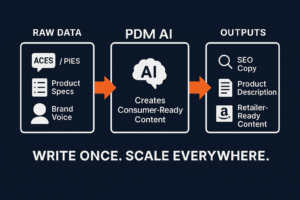Automotive aftermarket parts and accessory manufacturers who sell on Amazon are about to see changes in the documentation allowed on product pages.
To stay competitive, Amazon is making a big push to standardize product pages to make it as easy as possible for customers to find information about the products they are shopping for. For automotive accessories and part manufacturers, these changes are significant because many will dramatically impact how manufacturers convey crucial product information to their buyers.
As of January 29, 2024, sellers are no longer able to upload or edit the following unsupported document types on their product detail pages:
- 2D CAD
- 3D CAD
- Application Guide
- Brochure
- Comparison Chart
- Compatibility Guide
- FAQ
- Size Guide
- Specification Sheet
- Product Documentation
Existing documents will be visible until February 26, 2024. After February 24, any unsupported document types will be removed from your product detail pages and Seller Central.
In addition to product documentation changes, Amazon will also implement changes to photo requirements for each product listing. If the requirements are unmet, images from other Amazon selling partners will populate to remain compliant.
Each product detail page will now require at least three images:
- Product on a white background to show the product clearly
- Product in an environment showing its purported usage
- Photo with size and fitment information (especially important for
We know that changes like these can be challenging, but we’re here to help guide you through the ins and outs of this process so you can keep revenue flowing.
Why Is Amazon Changing Product Pages?
Despite the disruptive nature of major changes, these product listing edits are designed to provide a more seamless experience for Amazon buyers.
Instead of searching across a product listing for information like specifications or installation guides, companies must present the information more succinctly. In the end, this should not only help Amazon sell more products but should also help sellers push more products. We encourage sellers not to shy away from the changes but instead lean into them and create product content that will convert shoppers into buyers.
Since aftermarket companies want to avoid another seller’s photo on their listing, changing the photo requirements should inspire sellers to comply and utilize exceptional photography to fill in informational gaps. Automotive aftermarket companies should view these requirements as an expectation baseline and go above and beyond to tell their product’s story with exceptional photos.
What Product Document Types Are Acceptable?
Thanks to these significant changes, automotive aftermarket companies must reconsider how to present product information to customers.
Let’s start by going over what product types will be allowed under the new changes:
- Certificate of Analysis (CoA)
- Certificate of Compliance (CoC)
- Emergency Use Authorisation (EUA)
- EUA Amendments
- Fact sheet (Patient)
- Fact sheet (Provider)
- Installation manual
- Instructions for Use (IFU)
- Safety data sheet
- Safety information
- Troubleshooting guide
- User guide
- User manual
For a real-world example, let’s say that your company offers a custom-fitted seat cover that’s custom-sized for specific vehicle models. Before these changes, you could offer an Application Guide and a Compatibility Guide to help customers decide whether or not the seat covers offered fit and how to install them like a pro.
Now, instead of offering this information in separate documents, sellers will be required to consolidate this information into the user guide or user manual. In addition, sellers can utilize photos to show off the product and convey information about fitment or other crucial product information to help fill in the gaps.
This is a golden opportunity to effectively convey your product’s messaging and story to boost sales and minimize the possibility of returns.

Steps To Success
Here are the steps you need to take to make the required changes and ensure your success in 2024 and beyond:
- Focus on high-value documents: When choosing which documents to consolidate and re-categorize, it is important to concentrate on documents that receive the most attention from consumers. Begin by prioritizing migrating and updating of the pages that generate the highest traffic and conversions.
- Revise Product Descriptions: Incorporate vital details from unsupported documents into the product description section or compatible formats. This guarantees continued accessibility of critical information for customers.
- Enhance Allowed Documents: Use these changes as a golden opportunity to consolidate information from discontinued product documents and revise product content to tell your product’s story better.
- Verify and Enhance Product Images: Confirm compliance with Amazon’s revised guidelines for product images. Each product page must feature a white background photo showcasing the product, a lifestyle image, and a size/fit detail picture where relevant. Enhance any incomplete or subpar images as needed.
- Consistently Monitor Amazon Policy Updates: Stay abreast of any additional modifications to Amazon’s policies. Routinely monitor Amazon’s Seller Central or subscribe to avoid potential policy changes.
- Complete Submission Before Deadlines: Complete all necessary changes and submit final revisions before the February 26 deadline to mitigate last-minute complications.
- Seek Professional Assistance if Necessary: If you’re uncertain about the next steps, seek guidance from an e-commerce specialist or a professional photographer to guarantee your product pages align with the updated standards.
PDM Automotive Is Here To Help
Managing a catalog of products is tough without the right help in your corner.
PDM Automotive offers a range of products and services tailored for companies in the automotive aftermarket sector. Our cutting-edge PIM (Product Information Management) systems provide a seamless and efficient avenue for automotive brands to sell their premier products across leading eCommerce platforms such as Amazon. From comprehensive product descriptions to ACES and PIES data, PDM Automotive aids aftermarket companies in efficiently managing their product portfolios.
Beyond data management, PDM Automotive provides invaluable insights into sales data for multiple products in a centralized location. This visibility empowers companies to make data-driven decisions, pinpointing areas where products may underperform and uncovering potential catalog blind spots.
Contact PDM Automotive today for a demonstration of our offerings.



